What is accreditation?
Accreditation is independent recognition that an organisation meets the requirements of governing industry standards.
Health and community organisations are recognised for their commitment to best practice, quality, systems and processes and continuous improvement. This is acknowledged with the award of accreditation, certification and/or verification.
Being QIP accredited means patients, consumers and clients know that an organisation is committed to providing safe and quality service provision.
What is accreditation?
Accreditation is independent recognition that an organisation meets the requirements of governing industry standards.
Health and community organisations are recognised for their commitment to best practice, quality, systems and processes and continuous improvement. This is acknowledged with the award of accreditation, certification and/or verification.
Being QIP accredited means patients, consumers and clients know that an organisation is committed to providing safe and quality service provision.
How does accreditation work?
Accreditation is a cyclical process, meaning that it doesn’t end. It is embedded in how an organisation operates on a day-to-day basis. For most standards or frameworks, the process has six steps, but this can vary.
Accreditation usually starts when an organisation identifies that its processes and service delivery need to be assessed. Sometimes this will be identified so the organisation receives specific funding, become a Medicare-approved provider or eligible private health insurers service. Other times, it will be because an organisation wants to formally show their commitment to safety and quality. The common process is usually as follows:
1 Registration
After relevant standards or frameworks that match needs are identified, an organisation will register with an approved accreditation, certification or verification body of those standards or frameworks, such as QIP. If the organisation is starting a new cycle, this is known as re-registration.
2 Self-assessment
QIP provides the organisation with tools and resources to complete an internally led self-assessment against the chosen standards or framework. This is where the accrediting body matters. For example, QIP (for most programs), offers resources, online software and tailored support.
3 Application
When the organisation has completed their self-assessment, they can submit it and arrangements are made for assessment.
4 Assessment
An assessment is where the self-assessment of the organisation is checked against the chosen standards or frameworks. The assessment is completed by an experienced, qualified professional from the same sector. These are called different names – surveyor, assessor or auditor – depending on the accreditation, certification or verification program. The assessment is either completed on-site, telephone or online.
After the assessment, the assessor will prepare a report for submission to the accreditation body (QIP).
5 Decision
The decision is made by an authorised, independent decision maker, who is independent of the assessment process based on the assessment report. Some organisations may have a couple of items to fix, called corrective actions, others may have many. Accreditation is not a pass or fail, it is ongoing work to achieve. If all required corrective actions have been met, the organisation will then be granted accreditation, certification or verification.
6 Continuous quality improvement
Some standards and frameworks require a mid-cycle review, which checks the organisation against a progress report. This is usually halfway through the accredited. Certified or verified period.
To ensure best practice, organisations are encouraged to be proactive in making ongoing reviews and improvements throughout their non-self-assessment periods.
How does accreditation work?
Accreditation is a cyclical process, meaning that it doesn’t end. It is embedded in how an organisation operates on a day-to-day basis. For most standards or frameworks, the process has six steps, but this can vary.
Accreditation usually starts when an organisation identifies that its processes and service delivery need to be assessed. Sometimes this will be identified so the organisation receives specific funding, become a Medicare-approved provider or eligible private health insurers service. Other times, it will be because an organisation wants to formally show their commitment to safety and quality. The common process is usually as follows:
1 Registration
After relevant standards or frameworks that match needs are identified, an organisation will register with an approved accreditation, certification or verification body of those standards or frameworks, such as QIP. If the organisation is starting a new cycle, this is known as re-registration.
2 Self-assessment
QIP provides the organisation with tools and resources to complete an internally led self-assessment against the chosen standards or framework. This is where the accrediting body matters. For example, QIP (for most programs), offers resources, online software and tailored support.
3 Application
When the organisation has completed their self-assessment, they can submit it and arrangements are made for assessment.
4 Assessment
An assessment is where the self-assessment of the organisation is checked against the chosen standards or frameworks. The assessment is completed by an experienced, qualified professional from the same sector. These are called different names – surveyor, assessor or auditor – depending on the accreditation, certification or verification program. The assessment is either completed on-site, telephone or online.
After the assessment, the assessor will prepare a report for submission to the accreditation body (QIP).
5 Decision
The decision is made by an authorised, independent decision maker, who is independent of the assessment process based on the assessment report. Some organisations may have a couple of items to fix, called corrective actions, others may have many. Accreditation is not a pass or fail, it is ongoing work to achieve. If all required corrective actions have been met, the organisation will then be granted accreditation, certification or verification.
6 Continuous quality improvement
Some standards and frameworks require a mid-cycle review, which checks the organisation against a progress report. This is usually halfway through the accredited. Certified or verified period.
To ensure best practice, organisations are encouraged to be proactive in making ongoing reviews and improvements throughout their non-self-assessment periods.
How do standards and frameworks work?
Almost all standards and frameworks for health and community services organisation cover the topics of:
- Communication and information management
- Social, environmental and ethical responsibility
- Risk management, workplace health and safety (WHS/OHS)
- Governance, policies and procedures, including leadership
- Consumer information, privacy and safety
- Feedback, compliments and complaints
- Staff, human resources (HR), registrations and licensing
- Equipment maintenance, servicing and safety
- Inventory management
In addition to these, accreditation, certification or verification differs for healthcare organisations and community and human services organisations, which include:
Healthcare providers
- Infection Control
- Comprehensive care
- Medication safety and management
- Acute decline of a patient
- Blood management
Community services organisations
- Direction and accountability
- Valuing and empowering people
- Culturally safe services that embrace diversity
- Positive outcomes, focused on people's well being
- Program management, coordination and evaluation
- Accessibility for participation
What kind of organisations become accredited?
There is a wide spectrum of health and community service organisations across Australia who become accredited, certified and verified. QIP is proud to work with these organisations, which include, but are not limited to:
- Aboriginal & Torres Strait Islander support
- Aboriginal Medical Services
- After hours services
- Aged care support services
- Alcohol & drug (AOD) services
- Allied health services
- Audiology services
- Child, youth & family services
- Community organisations
- Corrective centre health
- Cosmetic medical & surgical
- Crisis or emergency services
- Day procedure services
- Private & public dental
- Diagnostic imaging services
- Dietetic practices
- Disability & human services
- Diversity services
- Domestic family violence services
- Early childhood intervention
- Endodontist services
- Fertility services
- Gambling rehabilitation & support
- General practices
- Hospice & palliative care
- Hospitals (public)
- Primary Health Networks (PHNs)
- Physiotherapy practices
- Podiatry practices
- Primary health care facilities
- Prosthodontic practices
- Psychiatry services
- Psychology services
- QLD coal mine workers
- Retirement villages
- Royal Flying Doctor Services
- Sexual assault/abuse services
- Specialised health services
- Women's health services
What kind of organisations become accredited?
There is a wide spectrum of health and community service organisations across Australia who become accredited, certified and verified. QIP is proud to work with these organisations, which include, but are not limited to:
- Aboriginal & Torres Strait Islander support
- Aboriginal Medical Services
- After hours services
- Aged care support services
- Alcohol & drug (AOD) services
- Allied health services
- Audiology services
- Child, youth & family services
- Community organisations
- Corrective centre health
- Cosmetic medical & surgical
- Crisis or emergency services
- Day procedure services
- Private & public dental
- Diagnostic imaging services
- Dietetic practices
- Disability & human services
- Diversity services
- Domestic family violence services
- Early childhood intervention
- Endodontist services
- Fertility services
- Gambling rehabilitation & support
- General practices
- Hospice & palliative care
- Hospitals (public)
- Private hospitals
- Housing & homelessness support
- LGBTQIA+ inclusivity
- Maxillofacial facilities
- Medical deputising services
- Men's health services
- Mental health services
- Non-government organisations (NGOs),
- Ophthalmology practices
- Optometry practices
- Orthodontist services
- Peak bodies
- Pharmacies
- Primary Health Networks (PHNs)
- Physiotherapy practices
- Podiatry practices
- Primary health care facilities
- Prosthodontic practices
- Psychiatry services
- Psychology services
- QLD coal mine workers
- Retirement villages
- Royal Flying Doctor Services
- Sexual assault/abuse services
- Specialised health services
- Women's health services
Benefits of accreditation
Consumer confidence
Reassures consumers and the local community of an organisation’s commitment to deliver quality-focused services and care.
Reduce business risk
Provides a platform for ongoing review, monitoring and improvement of health services’ systems, processes and culture; this enables risk management and mitigation.
Quality team
Educating and engaging teams in the process of quality improvement can build a culture of quality among staff.
Industry benchmark
Offers confidence to stakeholders of the service delivery provided and assists organisations to meet regulatory requirements for funding incentives.
Quality improvement
Reflects an organisation’s commitment to continuous quality improvements in systems, processes, policies, culture, risk management and staff management.
Enhanced services
Provides opportunities to identify areas for improvement and implement solutions to enhance patient care and service experiences.

